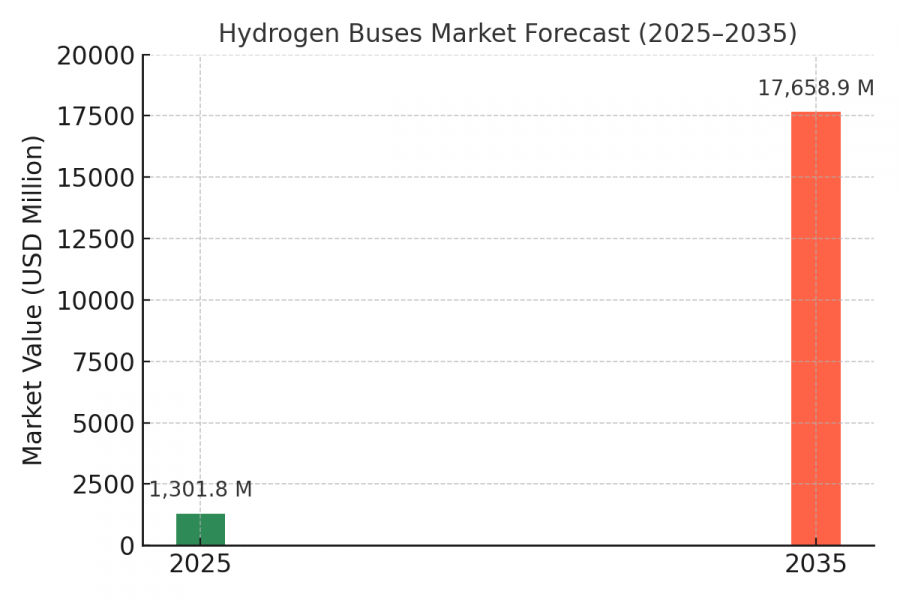
Hydrogen Buses Market to Surge from USD 1,037.1 Million in 2024 to USD 17,658.9 Million by 2035 at a 29.8% CAGR
Hydrogen buses market poised for rapid expansion by 2035, fueled by clean energy policies and zero-emission public transport demand.
NEWARK, DE, UNITED STATES, June 4, 2025 /EINPresswire.com/ -- The global hydrogen buses market size is estimated to reach a value of USD 1,037.1 million in 2024; strong year-on-year growth of 25.5% is projected, driving the market to USD 1,301.8 million in 2025; and from 2025 to 2035 the market is expected to record a compound annual growth rate (CAGR) of 29.8%, achieving a market size of USD 17,658.9 million by the end of 2035. This remarkable trajectory is underpinned by mounting environmental regulations targeting urban emissions, government incentives supporting zero-emission public transport, and rapid advancements in fuel cell stack efficiency that extend operational range while reducing total cost of ownership.
Get Ahead with Our Report: Request Your Sample Now!
https://www.futuremarketinsights.com/reports/sample/rep-gb-15953
Industry Dynamics and Opportunities
Major transit agencies and municipal authorities are actively piloting hydrogen bus fleets as part of broader decarbonization roadmaps; leading manufacturers are collaborating with hydrogen producers and infrastructure developers to secure fueling networks that guarantee round-the-clock operability; and the decline in fuel cell system costs—driven by scale-up of electrolyzer capacities and platinum catalyst innovations—is narrowing the price gap with traditional diesel or battery electric buses. Opportunities abound in establishing public-private partnerships to co-fund depot refueling stations, integrating green hydrogen from renewable-powered electrolysis, and bundling maintenance services with performance-based contracts that reward uptime and fuel efficiency. In emerging markets, where grid constraints limit fast electric charging, hydrogen buses offer a compelling alternative for high-frequency corridors and heavy-duty routes, presenting a clear entry point for manufacturers to gain first-mover advantages.
Key Takeaways for the Hydrogen Buses Market
Significant market value growth from USD 1,037.1 million in 2024 to USD 17,658.9 million by 2035 reflects a 29.8% CAGR; government mandates in Europe and Asia Pacific represent primary demand drivers through fleet replacement programs and clean-city targets; fuel cell system cost reductions and durability improvements are accelerating technology adoption; collaboration between OEMs, hydrogen suppliers, and public agencies is critical to infrastructure rollout and total cost optimization; and emerging economies with nascent bus electrification programs are poised to leapfrog directly into hydrogen solutions.
Emerging Trends in Global Market
The shift toward modular, standardized fuel cell units capable of rapid swapping is gaining traction to minimize downtime; integration of IoT-based telematics for real-time monitoring of hydrogen consumption and stack health is improving route planning and maintenance scheduling; hybrid drivetrains combining hydrogen fuel cells with auxiliary battery packs are emerging to capture regenerative braking energy; open-architecture software platforms are enabling over-the-air updates to fuel cell control algorithms and passenger infotainment systems; and the adoption of green hydrogen certified under renewable energy guarantees is becoming a differentiator for sustainability-focused transit authorities.
Significant Developments in Global Sector: Trends and Opportunities in the Market
Several landmark initiatives have catalyzed sector momentum: a consortium of European transit operators launched a 200-bus pilot powered by green hydrogen produced via offshore wind electrolysis; a major Asian bus OEM invested USD 500 million to establish a gigawatt-scale electrolyzer plant co-located with its assembly facility, ensuring secure hydrogen supply; North American cities are deploying hydrogen-refueling corridors supported by federal infrastructure grants; and technology partnerships are yielding next-generation membrane electrode assemblies that deliver 20% higher power density and lower platinum loading. These developments underscore opportunities for investors to back vertically integrated value chains, for service providers to offer bundled depot-to-route solutions, and for policy makers to refine incentive structures that de-risk early deployments.
Detailed Market Study: Full Report and Analysis
https://www.futuremarketinsights.com/reports/hydrogen-buses-market
Recent Developments in the Market
Over the past twelve months, hydrogen bus adoption has accelerated through high-profile contracts: a major bus operator in South Korea ordered 1,000 units with a delivery schedule through 2027, underpinned by a ten-year maintenance agreement; Australia’s first hydrogen bus rapid transit (BRT) line commenced operations, leveraging local renewable hydrogen; a leading European OEM unveiled a 12-meter hydrogen coach with extended range and enhanced passenger comfort features; and several hydrogen refueling station developers announced co-investment deals worth over USD 200 million to expand station density in urban and intercity hubs.
Competition Outlook
Competition in the hydrogen buses market is intensifying as established vehicle manufacturers, specialized fuel cell integrators, and agile startups vie for leadership. Key players include Ballard Power Systems, Toyota Motor Corporation, Solaris Bus & Coach, Hyundai Motor Company, and Van Hool NV;
Key Segmentations
Key segmentations cover vehicle length (10-meter standard, 12-meter articulated, 18-meter double-deck), fuel cell system capacity (50 kW to 200 kW), application (urban transit, intercity coach, school bus, shuttle services), integration model (OEM factory-built, retrofit conversions), and region (Europe, Asia Pacific, North America, Latin America, Middle East & Africa). Success in this dynamic landscape will hinge on securing long-term hydrogen supply contracts, advancing fuel cell durability, forging transparent total cost-of-ownership models, and aligning with evolving regulatory frameworks that encourage zero-emission fleets.
Electric Vehicles Industry Analysis Reports
Hybrid Vehicles Market Outlook 2025 to 2035
https://www.futuremarketinsights.com/reports/global-hybrid-vehicles-market
Electric Cargo Bike Market Size and Share Forecast Outlook 2025 to 2035
https://www.futuremarketinsights.com/reports/electric-cargo-bikes-market
Zero Emission Vehicle Market Outlook 2025 to 2035
https://www.futuremarketinsights.com/reports/zero-emission-vehicle-market
Electric Three Wheeler Market - Trends & Forecast 2025 to 2035
https://www.futuremarketinsights.com/reports/electric-three-wheeler-market
Electric Bike Market Forecast and Outlook from 2025 to 2035
https://www.futuremarketinsights.com/reports/electric-bike-market
Ankush Nikam
Future Market Insights, Inc.
+ +91 90966 84197
email us here
Visit us on social media:
LinkedIn
Facebook
YouTube
X
Distribution channels: Automotive Industry
Legal Disclaimer:
EIN Presswire provides this news content "as is" without warranty of any kind. We do not accept any responsibility or liability for the accuracy, content, images, videos, licenses, completeness, legality, or reliability of the information contained in this article. If you have any complaints or copyright issues related to this article, kindly contact the author above.
Submit your press release
